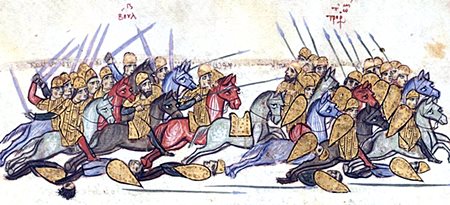
Battle of Anchialus(Battle of Achelous or Acheloos) |
year: 91720 August 917 |
| A landmark victory for the Bulgarians that secured their supremacy in Balkans | ★ ★ ★ ★ ★ |
|
enemy: Bulgarians
|
location: At Anchialus (modern Pomorie) on Bulgaria's Black Sea coast, in Burgas region
|
accuracy:
●●●●●
|
|
battle type: Pitched Battle |
war: Bulgarian Wars |
modern country:
Bulgaria |
| ▼ The Byzantines(emperor: Constantine VII Porfyrogenitos) | ▼ The Enemies | |
| Commander: | General Leo Phokas | Tsar Symeon I |
| Forces: | 30,000 to 62,000 | 60,000 |
| Losses: | Heavy | Heavy |
| Background story: |
| After their defeat in Boulgarophygon in 896, the Byzantines were forced to pay tribute to the Bulgarians. In 912 when Emperor Leo VI died, his brother Alexander refused to pay. King Symeon saw an opportunity to wage a new war and fulfill his ambitions to conquer Constantinople. Alexander died in the same year and the new administration under the Patriarch Nicholas Mystikos made attempts to avoid the war, promising that the infant Emperor Constantine VII would marry one of Symeon's daughters. At some point, the patriarch and Symeon even met outside the walls of Constantinople, performing a coronation ceremony. Thereafter, Symeon began using the title "Tsar of the Bulgarians", and the Greek title basileus in his seals. After a plot in the Byzantine court in 914 however, the new regent Zoe, Constantine's mother, rejected the marriage. In response, the Bulgarians raided Eastern Thrace and captured Adrianople in September 914, while the Byzantine army was occupied in the east. In the next year, the Bulgarians attacked the areas of Dyrrhachium and Thessalonica. Empress Zoe wanted to swiftly make a peace settlement with the Arabs and to engage the whole army of the East in a war against Symeon. The Byzantines also tried to find allies and sent emissaries to the Magyars, Pechenegs and Serbs but Symeon was familiar with the Byzantine methods and managed to prevent such alliances. Thus, the Byzantines were forced to fight alone. |
The Battle: |
 Battle of Anchialus in Skylitzes’ manuscript The Bulgarian Tsar concentrated his most powerful units in the two wings and left the center relatively weak in order to surround the enemy when the center would yield to the Byzantine attack. Symeon himself was in charge of a large cavalry unit hidden behind the hills. The Byzantine attack was fierce and it was not long before the Bulgarians began to retreat. Elated, the Byzantines started a bitter chase and their battle formations soon began to break, especially after a rumor spread that their commander, Leo Phokas, had been killed. At this point, Symeon, who had detected the disarray in the Byzantine formation, ordered his army to stand, and, at the head of his heavy cavalry corps, attacked the Byzantine left wing from behind the hills. The cavalry bore down at the confused enemy who immediately bent under their attack, panicked and took to their heels. The Byzantines were completely routed. Leo Phokas was saved by fleeing to Mesembria (modern Nesebar) but by the end of the day the Bulgarians overwhelmed the defenders of Mesembria and captured the town. Leo Phokas barely escaped by boarding a ship. |
Noteworthy: |
| The Byzantine historian Leo the Deacon says that 75 years after this military catastrophe the field at Anchialus was still covered with tens of thousands of skeletons. |
Aftermath: |
| The battle is considered a milestone for the history of Bulgarians. It secured the previous successes of Symeon I and made him the de facto ruler of the whole Balkan Peninsula except Constantinople and the Peloponnese. |
|
|
